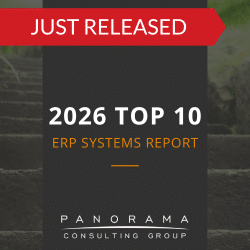Digital transformation in the energy industry is not merely an option—it’s a critical imperative for staying competitive.
With global trends shifting toward renewable energy, decarbonization, and enhanced efficiency, the energy sector faces a unique challenge: navigating a complex environment where technology investments, regulatory pressures, and shifting customer expectations intersect.
Today, we’re exploring the opportunities and challenges of digitalization in the energy industry. We’ll delve into key trends, strategic considerations, and practical recommendations for leaders exploring digitalization in the energy sector.
The 2025 ERP Report
72.6% of respondents said they've already deployed AI at their organizations. Learn about AI adoption and other ERP trends by downloading our latest report.
Top Energy Sector Digitalization Trends
Digital transformation in the energy industry is driven by several interrelated trends that are reshaping operational models and strategic priorities. Understanding these trends is crucial for energy companies looking to align digital investments with broader corporate goals.
1. The Shift Toward Decarbonization and Renewable Integration
Energy companies are under pressure from both regulators and consumers to reduce their carbon footprints. Digital solutions, such as advanced analytics, IoT sensors, and AI-powered ERP software, are playing a crucial role in integrating renewable sources, like wind and solar, into traditional energy grids. This is prompting companies to enhance grid management capabilities and develop predictive maintenance strategies that can handle variable energy production.
2. Increased Use of Smart Grid Technologies
The energy industry is transitioning from traditional grid structures to smart grids, which incorporate digital sensors, real-time monitoring, and data analytics to optimize energy distribution. Smart grids not only help in reducing energy losses and improving reliability but also support demand response initiatives. This capability is essential for utilities and power producers to balance supply with fluctuating demand.
3. Rise of Decentralized Energy Models
The adoption of decentralized energy models—such as microgrids, distributed energy resources (DERs), and peer-to-peer energy trading platforms—is transforming how energy is produced, consumed, and monetized. These models require robust digital infrastructure, including blockchain for transaction validation and AI for dynamic energy pricing.
While this trend shows significant potential for improving energy access and efficiency, it also necessitates new business models and regulatory frameworks, posing a challenge for traditional utilities.
4. Data-Driven Decision-Making
One of the most impactful trends in energy sector digitalization is the use of big data and predictive analytics. From asset management to real-time monitoring of energy production, data is being used to optimize supply chains and improve energy forecasting accuracy.
For example, a utility company might analyze weather patterns alongside historical consumption data to dynamically adjust energy distribution across different regions. This would reduce costs and enhance sustainability by optimizing energy generation based on real-time conditions.
5. AI and Machine Learning for Operational Efficiency
While artificial intelligence has many use cases, it has been especially useful when it comes to automating routine tasks and optimizing maintenance schedules in the energy sector. This is helping companies reduce operational costs by identifying inefficiencies that are not visible through traditional means.
For instance, instead of using a fixed maintenance schedule, a company might use AI to analyze their entire fleet’s workload, prioritize equipment based on operational demand, and reschedule non-essential maintenance to low-activity periods.
How to Navigate Digital Transformation in the Energy Sector
Here are some expert tips for successfully adopting new technologies in the energy industry, whether it’s an industry-specific ERP system or an IoT device for monitoring energy consumption.
1. Build a Digital-Ready Workforce
Building a workforce that is comfortable with new digital tools and platforms is a major challenge for any industry, and the energy industry is no exception.
We recommend focusing on change management and digital upskilling to ensure your workforce is prepared for new technology. When our ERP implementation consultants develop change management plans for clients, we help them identify barriers to change, develop a training strategy, and outline a communication plan.
2. Consider Regulatory Complexities
The energy sector is already heavily regulated, and digitalization adds another layer of complexity on top of this. For instance, integrating renewable energy sources and adopting decentralized models require navigating various local and international regulations.
Leaders must stay ahead of the regulatory curve by investing in digital compliance tools and actively engaging with policymakers.
3. Manage Cybersecurity Risks
As energy companies become more digitally connected, they are also more vulnerable to cyberattacks. Investing in robust cybersecurity measures and developing a proactive cybersecurity culture is critical to avoiding consequences such as operational disruptions and environmental hazards.
4. Balance Profitability and Sustainability
Leaders should focus on implementing digital tools and technologies that can simultaneously reduce operational costs and drive environmental benefits.
For instance, AI-powered predictive maintenance can lower maintenance costs while extending asset lifespan and minimizing resource usage. Similarly, smart grid technologies can decrease carbon emissions while optimizing costs.
Prioritizing high-impact digital initiatives that align profitability and sustainability is essential for balancing these dual objectives.
5. Consider the Barriers to Digital Transformation in the Energy Sector
Oftentimes, energy companies struggle with organizational silos that hinder cross-functional collaboration. Leaders must break down these silos to ensure digital goals align across departments.
Another challenge is strategic misalignment. It’s vital to secure stakeholder buy-in by communicating openly and demonstrating tangible benefits.
There are many other barriers to anticipate, so we recommend developing a proactive plan to address the most common digital transformation risks.
Learn More About Digitalization in the Energy Industry
Digital transformation in the energy industry requires a strategic approach that aligns digital initiatives with both environmental and financial goals.
Our business software consultants understand the trends driving digitalization in the energy sector. We can help you implement solutions that enhance efficiency and improve sustainability, while giving you a competitive edge.














